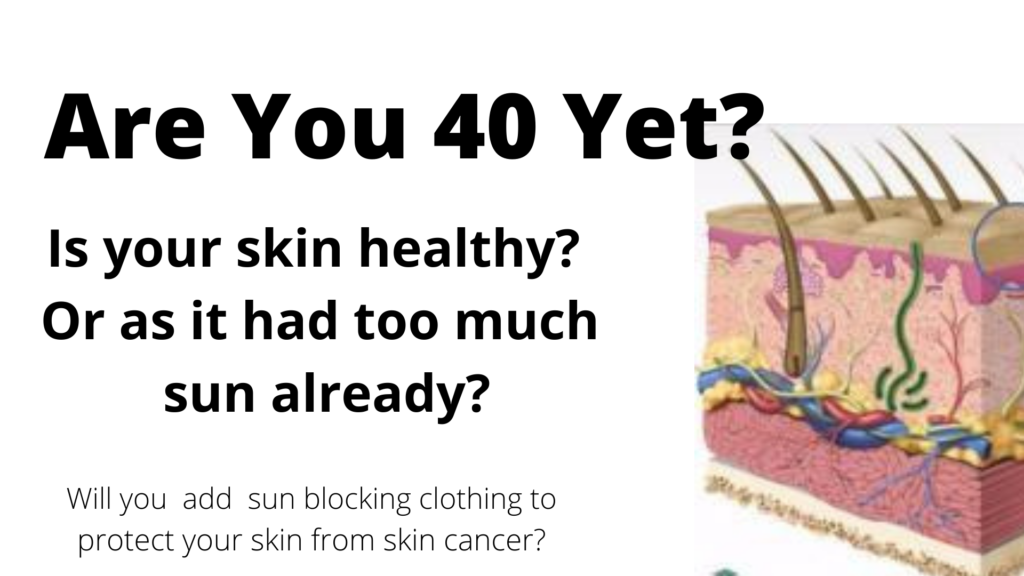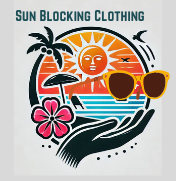Are You 40 Years Of Age Already?

Do you know Why Age Is A Risk factor For Skin Cancer After You Turn 40? When you reach 40, watch out. Research has concluded that by the time you are 40, most of you are at a time in your life when you will have your highest annual exposure to the sun!
Maybe you aren’t out in the sun, at 40 as much as when you were a kid, but the most since becoming an adult. With careers and less free time, it often seems important to get too much sun on your days off or vacation.
Lifestyles and interests have you out in the sun more, especially for men at this point in your life. More sun exposure and longer exposure times at this age.
Maybe not exactly on the year of your 40th birthday, but somewhere in that particular period, you will probably receive your highest yearly exposure to UV.
At this point, your years of exposure are stacking upon you, and the damage that has been done to your skin will begin to show.
For women, their skin may be showing the years and sun exposure, but they are usually more apt to respond to the things they see happening to their skin by adding some protection from the sun.
One of the things that happen as you reach 40 years of age? For most of us, that is the time when your body is giving off those little signals that it is ready to declare itself unable to keep up with the demands of your life.
Your skin looks a bit dry, your joints ache a bit. Energy levels aren’t quite where you would like them to be. Bits and pieces will start showing wear. This is the time to start giving your skin some extra care and attention. Prevent any shocks along the way.
At What Age Does Sun Damage Show?
Your skin is the organ that gets the most sun. This makes it important to get into the protective mode.
At what age does your sun damage start showing up?
When it comes to signs of sun-damaged skin, like wrinkles or dark and pigmented spots, most people start noticing these issues as early as their mid-twenties or early thirties.
While wrinkles aren’t harmful, they can cause some of you to feel self-conscious.
With the ability to use sun blocking clothing as a barrier between you and the sun, taking care of your skin is easier, but still has to be done. Wearing your sunglasses and sun hat is where you start with protecting your skin from the sun.
Then a loose-fitting sun blocking long sleeve shirt to protect the trunk of your body. With your sun hat and sunglasses, the sun blocking shirt gives you a good start.
Long pants or long skirts and shoes, not flip-flops or sandals. Skin protection is important. Remember to use sunscreen on the parts of your body that are not covered.
Another issue that is appearing for all of us, not just you who are entering your 40s is the disappearing ozone layer. This is happening, and we have to prepare for it. You don’t have the protection I had as a younger person.
At Forty, You Have Risks

This is the age that your body begins the transfer from efficient operation to a more mature health situation. We have by now taken enough chances with our body and its ability to heal and repair itself that there will be some times that it just can’t keep up.
While skin cancer is the most preventable of all cancers, it is still the most common one found by the medical community.
We do know that most skin cancer is caused by damage from the sun’s UV rays. This exposure of our skin to the sun can be protected against. Make yourself aware of the sunshine, and how hot it is, and make plans to protect yourself from too much sun.
A wise combination of wearing sun blocking clothing, applying sunscreen, and seeking shade during peak sun hours will keep your skin healthy, and slow down your risk of skin cancer.
Our society has decided to throw caution to the wind, and allow the sun to shine too long on bare skin that has no protection. We wear tank tops in the direct sun. We ignore wearing sun hats and sunglasses. Forgetting to apply sunscreen. Then we use little caution for the hours we choose to be out in the sun.
These are choices we make, and our lifestyle is not good for skin protection. There has to be some allowance made for your skin to be protected and allow time for healing. Just because your skin has always popped back from the sun abuse in the past doesn’t mean it always will.
Number Of People Treated For Basil Skin Carcinoma Annually?
Nearly three and one-half million people are treated for this kind of skin cancer each year, in the US. (According to Skin Cancer.org)
Now that we know we can use sun blocking clothing to protect us from the sun, these numbers should go down.
Will you wear UPF clothing to protect your skin from the abnormal growth of skin cells?
When you have cancer anywhere on or in your body, you have uncontrolled growth of cells. So it follows that skin cancer is the uncontrolled growth of SKIN cells.
This most common of all kinds of skin cancer is known as Basal Cell Carcinoma. It is in the outermost skin cells, your basal skin cells. That top layer of skin gets lots of wear and tear.
Will wearing the basics of sun blocking clothing, a sun hat, sunglasses, and a long-sleeve loose-fitting tightly woven shirt help protect you?
When there is early detection and treatment, almost all basal cell carcinomas (BCCs) can be successfully removed. And removed with few complications. Once diagnosed, wearing sun blocking clothing can help protect you from more of these skin cancers.
Look out for BCC warning signs, including new, changing, or unusual skin changes, so you can spot skin cancers when they are easiest to treat and cure.
Early detection is the secret to complete healing. Remember, the skin cells become weak from too much sun, after a while. They can’t and won’t continue to be healthy thriving skin cells if you continue to allow too much sun time.
This kind of cancer is seldom serious unless ignored. Then it can grow to be an open sore that will destroy your healthy skin all around the affected area.
This kind of cancer can be the first you see, before or after you become 40 years old. As you get older, this will be what you are most at risk for.
Squamous Cell Carcinoma Comes With More Issues
Squamous cell carcinoma or SCC of the skin is the second most common form of skin cancer.
This is also abnormal and accelerated growth of squamous cells. This layer of your skin is right under the outer skin.
If this is caught early, usually SCCs are curable. Once the affected area is removed, there will be no more issues, and the wound will. heal cleanly.
Squamous cell carcinoma of the skin falls under a category also known as cutaneous. Our dermatologist does not lump squamous cell carcinoma into the cutaneous group, but some may.
It is important to read about these different stages of skin cancer so that if you are diagnosed, you will be working with labels or descriptive terms you have heard of. Too often, those in the medical profession use medical terms we are not familiar with.
Remember the odds? 1 person in 5 will have skin cancer. So in your group of friends, who is the 1? Having some preparation will help you be more supportive.
Our dermatologists use the terms to describe our issues that they use daily. However, it can sound different and threating to those of us who are not so familiar.
If you have as many members of your family seeking treatment as we do, the terms become more familiar.

Your Squamous Cells Shed All The Time
One of three main kinds of cells in the top layer of your skin or your epidermis, these squamous cells are flat cells located near the surface of the skin. And they shed continuously as new ones form.
Squamous Cell Carcinoma happens when DNA damage from exposure to ultraviolet radiation, usually from the sun causes abnormal changes in the squamous cells. They can no longer reproduce themselves correctly, and the outer layers won’t always lay down flat and smooth as before.
Squamous Cell Carcinomas can appear as:
Scaly red patches
Open sores
There can be rough, thickened, or wart-like skin.
In these places of damaged skin cells, there can be raised growth with a central depression. (a raised area with a sinking middle)
Sometimes, these SCCs may crust or heal over, seep, itch, or bleed. These lesions most commonly grow on sun-exposed areas of the body.
However, Squamous Cell Carcinoma does also occur in other areas of the body, including the genitals.
When Squamous Cell Carcinoma cancer develops in the epithelial or “skin” lining of the vagina, vulva, cervix, and penis.
Squamous Cell Carcinoma of the genitals is usually associated with the human papillomavirus (HPV) infection. The majority of cancer that appears in the vagina, vulva, cervical and penile cancer are squamous cell carcinoma. (More explanation at TreatmentPennMedicine.org)
Then We Have Melanoma, What Is It?
Melanoma is another type of skin cancer. This one occurs when the pigment-producing cells are down a bit deeper in our layers of skin.
These pigment-producing cells are melanocytes. This is the layer where you get your tan. When these cells do what their design is to do, you will have a tan that will protect you from the sun.
However, if these melanocytes get any damage from the radiation in the sunlight, they can mutate and become cancerous.
Melanoma is the most serious form of skin cancer and is the fifth most common cancer among both men and women.
Now here is where things get scary for me: Even though invasive melanoma accounts for only about 1% of all skin cancers, it is responsible for the majority of deaths from skin cancer.
Melanoma is dangerous because it is more likely to spread or metastasize than other skin cancers. It is much more aggressive than basal cell carcinoma and squamous cell carcinoma.
Most of our pigment cells (melanocytes) are found in the skin. As a result, the majority of melanomas are found on the surface of the skin.
Usually, these melanomas are found on the back, neck, or legs. But melanoma can also occur in the nail bed
While this form of melanoma does not happen often in the general population, acral lentiginous melanoma or ALM is the most common type of melanoma in people with darker skin or those of Asian descent.
AimMelanoma.org has a bit more information here (acral lentiginous melanoma).
Other Areas Of Your Body Where Malonima Can Occur
Then there is melanoma in the eyes which is known as ocular melanoma. When melanoma grows on internal mucosal surfaces, it is called mucosal melanoma. This form of melanoma will be located in the lining of the sinuses, mouth, anal canal, or vagina.
Melanoma can develop anywhere melanocytes are found. But some areas are more prone to melanoma than others.
In men, it is most likely to affect the back and the head/neck area. For women, the legs are the most common site. Other common sites are the neck and face.
Children can also develop melanoma. A rare condition that will occur at birth or soon thereafter is a form of skin cancer. A congenital pigmented or melanocytic nevus is a dark-colored, often hairy, patch of skin.
It is present at birth or appears in the first year of life. I mention it here, in the name of education. I have never seen this kind of skin cancer on a little one. Again, should you be faced with this condition in your family, you will have heard of it occurring.
I have heard of one such condition, and the person sharing the story with me did not have facts. The whole thing was treated like a “witches getting revenge on someone!” The child did not live in this case.
Health care workers are saying that in 2022, an estimated 197,700 cases of melanoma will be diagnosed in the United States.
Of those, 97,920 cases will be in situ or non-invasive. This means that the area is confined to the top layer of skin. The epidermis is usually how the word for the top layer of skin.
It is also predicted that 99,780 cases will be invasive. This means that the melanoma tumor or growth will penetrate the epidermis into the skin’s second layer of the dermis.
These invasive cases are estimated to be divided, with 57,180 in men and 42,600 will be women. So everyone is at risk.
The number of new cases of melanoma is steadily increasing over the last 30 years.
Death rates were increasing through 2016 is thought to be the result of the popularity of sunbeds. Information and knowledge are thought to be the reason for the decrease, in addition to improvement in overall survival as a result of new treatments.
5.4 Million People Are Treated For Melanoma Every Year
The number of people treated for nonmelanoma skin cancer each year, is high, considering it could be prevented. Even though melanoma happens deep in the skin, where it sometimes is not found in the early stages, people are not as concerned as they should be.
Using sun blocking clothing to keep the direct sun off your skin is step 1. Wearing a sun hat, with a 3-inch brim to help keep the sun off your head, ears, nose, and neck is first. Your head is the first part of you that the sun reaches. Protect it for healthier skin.
Your sunglasses are step 2. Well-fitting sunglasses that block the sun from your eyes are important for children as well. Your family needs to get in the habit of wearing sunglasses in the sun.
A sun blocking loose-fitting long sleeve shirt will protect the trunk of your body while you are in the sun. The loose fit will allow your body to get air and be able to cool itself.
These 3 items will give you a head start in protecting yourself from melanoma. Will your case of melanoma be one of the cases prevented this year. Protect yourself from the sun.
While we are talking about the protection of wearing sun blocking clothing here is another number you don’t have to belong to. Out of every 5, Americans will develop some form of skin cancer this year. Are you going to be the one?
Explaining How Tumors Can Happen
I remember a description of how melanoma gets started that has stuck with me. Maybe it will help you remember too.
Your skin has a layer down where the pigment-producing cells that are known as melanocytes live. Their job is to protect your skin when they receive the signal that the sun is shining directly on you.
When that signal goes off they are supposed to reproduce themselves and bunch together and form a dark cover the sun can’t get to so your inner layers can keep working and keep you safe.
The first few times this works great, and everything is fine. But then, the day comes when you forgot to put on sunscreen and you got a sunburn.
All the while, the message is being sent to hurry up and make some more melanocytes. The sun is hot and we need more. Hurry, hurry! The messenger melanocyte got so frazzled he couldn’t remember the message he was to deliver.
The messenger melanocytes became so frazzled he didn’t remember if he was to say “make more,” or “stop now, the danger is over.” Those trusty little melanocytes just kept churning out more melanocytes.
These cells had no place to go or job they could identify with, so they just sat there and piled up. Soon a tumor was growing.

Are You 40 Already? Only 15 More Years!
Only 15 more years till you reach 65!
Half the Americans who live to 65 will receive the diagnosis of at least one form of skin cancer.
Would you believe that the kind of cancer in your diagnosis is rarely a fatal form of skin cancer? Remember the two kinds of less serious skin cancer you have already read about? The ones called basal and squamous cell carcinomas?
Remember the primary cause? Yes, sun exposure!
You can work on that sun exposure stuff, you have sun blocking clothing and sunscreen!
40 Years And Older
If you protect yourself from the sun during the first 18 years of your life, you can reduce the risk of some types of skin cancer by up to 78 percent.
Taking a few precautions is worth the risk of any skin cancer. As you get older, the results of the time you spent unprotected in the sun will begin to show.
Did you spend a lot of time in the sun as a younger person? You will probably see a lot of early aging signs, as well as having your risk factors ramp up.
If you didn’t spend quite so much outside in the sun, your early aging should be slower. Plus there will be a smaller risk of skin cancer as you age.
As we are finally realizing the benefits of a healthier lifestyle, a few safe sun habits will make your longer life more enjoyable.
US Citizens Pay $8.1 Billion For Treatment Each Year
An accurate estimate of the total cost of treating skin cancers in the US is just over $8 billion. That is just for medical care.
Of the $8.1 billion, $4.8 billion is for all the nonmelanoma skin cancer costs.
Leaving $3.3 billion for melanoma.
This figure does not even touch what people spend on early aging skincare. How big is the skincare market in the US?
As of 2020, we, here in the US are the world’s most lucrative skincare market. Revenue of nearly $18 billion annually means skincare is getting its share of the sales.
How many of these dollars will you spend to try to get back the youthful appearance that you want to once more enjoy? I am glad to see that skincare has not lost its market during the time we didn’t wear makeup because of face mask-wearing.
Finding out that you can keep your skin looking more youthful with the simple routine of applying sunscreen every morning offers the best way to take care of your skin.
The wide spectrum of sunscreen that we now have access to, even if you are already 40 will save your hard-earned dollars in the next years of skincare. Of course, if you sweat your sunscreen off, or otherwise cause it to quit protecting your skin, you will need to reapply.
25 % Of the Regular Population
69 % Of Users Of Tanning Beds
For the normal population of people, as they move about in their day, 20% will develop skin cancer. Remember, 1 person out of 5 back earlier in this article?
The percent of increased risk for indoor tanners is near 69% that you will have one of the skin cancers. That is a hefty price tag for a tan.
There is a much healthier option in artificial tan if you have not kicked the tanning habit. However, a balanced natural look for your skin is healthier and has fewer consequences.
In light of the dangers of tanning beds, 30 million people in the US make use of tanning beds. Unfortunately, 2 to 3 million of these are teenagers. This makes for a continuing trend of higher skin cancer risks in future years.
Melanoma Is The 5th Most Common Cancer
Melanoma is the fifth most common cancer for males and females. It is also the most deadly of all skin cancers. Part of the reason the cancer is so deadly is that it is not always easy to see.
As it is happening deeper in our skin layers, the melanoma can already be invading some other part of our bodies before we find it. It doesn’t usually cause pain during the first months. You can’t see it. You simply must prevent melanoma.
Did you know that one person dies of melanoma every 57 minutes? This adds up to about 10,000 people a year.
Another disturbing fact is that if you have had 5 or more sunburns in your life, your risk for melanoma doubles! How many have you had? I know I have had more than 5! That happened by the time I was 15!
If the Dermatologist detects the melanoma while still in the localized stage, before the tumor can spread to another part of the body, your survival rate is 98%. This is a skin cancer we can successfully treat. However, you must know you have it!
How Long Is It Safe To Expose Your Skin To The Sun?
The medical community tells us that it is safe to expose your bare face, arms, and hands to the sun for about 15 minutes a day, 3 days a week. This is enough to give you exposure to make vitamin D. So we can’t use the need for making vitamins as an excuse to get too much sun.
This exposure should happen before 10 AM or after 4 PM, during the late spring, summer, and early fall days. The high intensity of the sun during these hours is too hard to control, and repairing damage is next to impossible with accidental overexposure.
Just don’t get out without protection during the more dangerous hours.
Don’t forget to apply at least the minimum recommended SPF (sun protection factor) of 30 for sunscreen, the strength to protect your skin daily. Just a reminder that the higher the SPF, the more protection there is against the harmful effects of UV radiation.
Apply sunscreen to your unprotected skin at least 30 minutes before outdoor activities for maximum protection against the sun’s rays.
Reapply sunscreen every two hours or after swimming, towel drying or sweating, or as the bottle instructs.
When you have a sunblocking hat, your sunshades, as well as your long sleeve loose-fitting shirt on, you are leaving less skin to protect. Don’t think that because you have less skin to protect that you can be careless.
Be sure and wear gloves, and long pants, or deal with applying and re-applying sunscreen as needed.
Just In Case You Are 65!
Now is not the time to forget to take care of yourself.
All too often senior citizens seem to feel that after living to be 65, they can just cast caution to the winds, especially when we are talking about sun exposure.
The thinking seems to go like this: “I’ve never had skin cancer. It takes ages for skin cancer to develop, so I’m never going to get it. I’m moving to Arizona or Florida and spending the rest of my life in the sun.”
That thinking brings to mind Mickey Mantle, who died of cancer at age 63. He gets credit for the statement that “If I knew I was going to live this long, I’d have taken better care of myself.” Regardless of the accuracy of who made this statement, we do need to continue to take care of our skin, even when we become senior citizens.
Senior Citizens Should Have A Plan for Safer Fun In The Sun
Taking care of yourselves can help allow for longer lives. By using common sense habits, you can stay strong and healthy as long as possible.
The average length of life in our industrial world has been rising quickly.
At least according to the records of the Bureau of Labor Statistics:
People still working aged 65 or older have grown by 117% in a span of 20 years.
The new data from epidemiological, biological, and molecular research and tabulation is pointing to skin cancer proving to be a disease that can be more deadly for the elderly.
We already know that one in five Americans will develop skin cancer by the age of 70.
The data also concluded that the majority of people who will develop melanoma are white males who are over age 55.
This is piling up evidence that senior citizens must continue to take better care of their skin. Pay more attention to when they choose to be out in the sun and protect themselves better. It is easier to do now than ever, with the sun blocking clothing now available.
Will Your Senior Years Find You Healthy?
With more than half of the skin cancer-related deaths occurring in senior citizens who are older than 65 years old, we are making decisions that are not in our best interests.
As we live longer, the more likely we are to develop skin cancer. Often when found in older patients, there is a greater chance of dying from it.
Why this is true.
Most skin cancers result from sun damage over the course of your life, and seniors have lived longer.
There have been more sun exposures with more damage from ultraviolet (UV) light.
Both sunburns and suntans do damage to your skin’s DNA.
Accumulating More Danger
The radiation from the suns’ rays has been breaking down your skin’s tissues so that it looks and performs like older skin before it should.
The sun has also been producing genetic defects that can lead to skin cancer. Suffering just 5 sunburns over your lifetime more than doubles your chances of developing melanoma, and each successive tan or sunburn continued to raise the risks further.
We never know exactly how much damage it will take to trigger skin cancer, but one bad burn in older age may be the straw that breaks the camel’s back. If you didn’t check out this link earlier, check it out now to see how people age with the sun.
Making matters worse, as sun damage adds up, our ability to evade problems keeps diminishing.
As we get older, our skin undergoes changes that reduce our defenses. We develop weaker immune systems, poorer healing capacity, thinner skin, and damage from external factors like smoking and pollution.
These changes all contribute to faster and earlier skin aging. Don’t forget that you are also increasing your risk for skin cancer.
The Human Body Ages Inside And Out!
There are even names for the 2 types of skin aging that humans experience if they live long enough.
Intrinsic, or normal chronological aging, is the aging that we all experience.
Then extrinsic aging, whose causes are external factors like ultraviolet (UV) light exposure from both sunlight and tanning beds. We also have industrial chemicals, human immunodeficiency virus, and environmental pollutants. All play a part in skin cancer.
Getting Older Requires Taking Care Of Yourself If You Want To Enjoy Your Life
Intrinsic Aging: As you get older, your skin loses fat and water content and becomes thinner, allowing UV light to penetrate more deeply.
This is happening while the body’s natural ability to repair damaged DNA is weakening. These 2 events increase the likelihood of abnormal cell growth that can cause mutations leading to skin cancer.
The overall natural decline in your immune system leaves you unable to respond and may allow prior DNA damage to progress to cancer.
These events will leave us more susceptible to cancers from future DNA damage from sun exposure.
Then all those diseases and conditions related to aging kick in and contribute to this immune decline.
Atherosclerosis, diabetes mellitus, and congestive heart failure, for example, impede blood flow. This increases faulty immune responses, handicapping the skin’s ability to heal.
Using Common Sense As You Age Will Add Years To Your Life
Extrinsic Aging is also going on because many older individuals vastly increase their UV exposure. Retiring and moving to sunnier locations and enjoying more outdoor activities like golf, fishing, and tennis.
Since UV from sunlight suppresses the immune system, the result causes our natural immune decline and puts in place a situation that allows for the development of skin cancer.
UV light also breaks down elastic tissue or elastin in your skin over time. This is a leading cause of wrinkles and sagging of your skin. It also leads to discoloration and blotchiness, which is so frustrating as we age.
The skin is especially susceptible to sun damage since it covers the entire surface of your body.
Your Skin
Your skin is the first organ to come in direct contact with UV rays.
At one time, we thought that most sun damages occurred before age of 18 and that this early damage triggered most of the genetic changes that later led to skin precancers and cancers.
Resulting in opening the door for some older people to think, “It is too late, I already have damage; there’s nothing I can do about it.”
However, later research has shown that we continue to experience substantial UV exposure as long as we live.
Most of your exposure is occurring after age 40. This later in life exposure is often what kicks in to contribute to skin cancers, so sun protection remains extremely important to continue throughout your life.
Since we now know that UV exposure is its primary cause, skin cancer is almost entirely preventable.
Protection And Prevention

Fortunately for senior citizens, prevention is not a huge burden. You just have to do it!
Think of it as a three-pronged program:
- Stay out of tanning beds
- Use effective sun protection
- Check your skin.
The first part is easy, simply never climb into a tanning bed. More people develop skin cancer because of UV tanning than develop lung cancer because of smoking.
Proper sun protection starts with timing.
The hours between 10 AM and 4 PM are typically the most UV-intense, so plan outside adventures for early morning or late afternoon.
When you do go outside, try to stay in the shade, not in the direct sunlight, and wear sun-safe clothing.
Sun-safe clothing includes:
A long-sleeved shirt and long pants made of densely woven materials, a hat with a wide brim, and UV-blocking sunglasses.
Use an SPF 30 or higher broad-spectrum sunscreen (SPF 30+, water-resistant sunscreen for extended or intense outdoor exposure such as on the golf course) and reapply at least every two hours or immediately after swimming or heavy sweating.
It also helps to be aware of your skin type. Go to SkinCancer.org/quiz to find your skin type.
Pay Attention To Your Skin
Finally, along with protecting your skin, don’t forget to watch for suspicious growths. The Skin Cancer Foundation recommends head-to-toe self-examination once a month and an annual visit to a dermatologist for a professional total-body exam.
This will give you the best chance of discovering skin cancer at an early, easily treatable stage.
As a rule of thumb, look out for anything new, changing, or unusual.
Pay attention to any growth, including warts and moles, crusty spots with irregular borders, multiple colors, increased size, or any other notable change.
If you have persistent pain, irritation, itching, bleeding or crusting at any skin site, bring this to your dermatologist’s attention. Don’t forget to mention any new lesion appearing after age 40.
If you’re concerned about the sun damage you’ve already accumulated, a dermatologist may be able to help repair some of it.
Senior Citizens Can Get Some Help For Too Much Sun In The Past
Dermatologists have a number of techniques such as lasers and photodynamic therapy, dermabrasion. There are also topical medications like retinoids.
Using these treatments helps to rejuvenate your skin while also removing precancerous lesions, thereby reducing your risk of skin cancer.
I’ve heard more than one older person say something like, “When I was young, no one used sunscreen. It’s too late to change the past, so if I get skin cancer, I get it.”
So, you now know that’s not true. You also know that it’s never too late to reduce your skin cancer risk.
Pay attention to how much sun your skin gets, and you will vastly improve your chances of avoiding skin cancer or catching it when it is easily treatable.
Don’t forget the importance of overall health. Well-balanced nutrition and good health habits, help keep your immune system strong so that you can better fight off skin diseases.
Dangerous habits like smoking, excessive alcohol consumption, and drug dependency all contribute to skin issues.
The results of bad habits add up, increasing your chance of any and all diseases, including skin cancers. So take care of yourself.
Enjoy life after you turn 40 years old. Adjust your lifestyle to keep you healthy.

Sami’s Take On Why Age Is A Risk Factor For Skin Cancer After You Turn 40
Taking sun safety seriously and taking care of our skin all through life is important. I thought I was paying attention, but sure enough, while I wasn’t watching, I was past40 and the aging signs had made their appearance.
Being able to take care of and prevent some of the damage of prior generations will help you age slower. Wearing sun blocking clothing will make it easier to keep your skin safe from the sun.
Don’t forget your water intake. Staying hydrated is also a great help to avoid early aging skin. Adjusting your lifestyle to have outside times before 10 AM and after 4 PM during the hotter times of the year will help keep you safer.
Start early in your life, and make your habits support a healthy life throughout your life.
